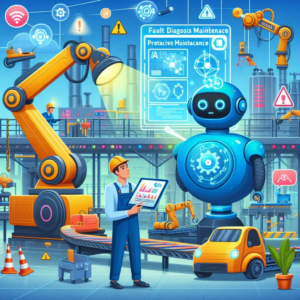Fault Diagnosis in Smart Manufacturing Explained

1. Introduction
In modern manufacturing, fault diagnosis is crucial for improving efficiency, reliability, and cost savings. Traditionally, industries relied on manual inspections and reactive maintenance, which often resulted in unexpected downtime and increased costs. However, with the rise of intelligent fault diagnosis systems, businesses can now shift to proactive maintenance. This allows them to detect problems early and fix them before they cause major failures.
To fully embrace this transformation, manufacturers are moving towards cloud-based solutions. By integrating AI-driven fault diagnosis with cloud computing, they can analyze real-time data and improve decision-making. As a result, they enhance equipment lifespan and reduce maintenance costs.
2. The Importance of Fault Diagnosis in Smart Manufacturing
Fault diagnosis plays a key role in keeping manufacturing processes smooth, safe, and cost-effective. Even small equipment failures can disrupt production, leading to significant delays. Therefore, industries need advanced fault detection to prevent such issues.
With the rise of Industry 4.0, manufacturers are focusing on data-driven decision-making. By using hybrid cloud solutions, they can process massive amounts of sensor data, detect failures early, and schedule maintenance at the right time. Consequently, they improve productivity while reducing downtime.
3. Challenges in Traditional Fault Diagnosis
Despite its importance, traditional fault diagnosis methods face several limitations:
– Overwhelming Data Volumes: Smart factories generate vast amounts of data, making it difficult to extract meaningful insights.
– Complex Machinery: Modern manufacturing systems involve interconnected components, increasing fault detection challenges.
– Skill Gaps: A shortage of experts in AI-based diagnostics slows down problem resolution and maintenance actions.
4. Intelligent Fault Diagnosis Techniques
Advanced technologies, particularly machine learning (ML) and AI, enhance fault diagnosis by automating detection and predictive maintenance. These techniques fall into three categories:
4.1 Supervised Learning for Fault Diagnosis
Supervised learning trains AI models using labeled data. This means the system learns from past equipment failures and applies that knowledge to predict future issues. Consequently, industries can detect problems early and avoid costly breakdowns
4.2 Semi-Supervised Learning for Predictive Maintenance
Semi-supervised learning uses both labeled and unlabeled data. Since labeling data is often time-consuming, this method helps industries save time and resources. As a result, fault detection models become more accurate while requiring less manual effort.
4.3 Unsupervised Learning for Anomaly Detection
Unsupervised learning does not need labeled data. Instead, it looks for unusual patterns, making it useful for detecting unknown faults. With this technique, industries can discover hidden issues before they lead to bigger problems.
5. Dimensionless Eigenvalue Extraction for Accurate Fault Detection
One of the biggest challenges in fault diagnosis is processing data efficiently. To solve this, manufacturers use dimensionless eigenvalue extraction. This technique helps identify critical features, making it easier for AI models to analyze faults. As a result, the system detects failures faster and more accurately.
6. Fault Prediction and Cloud-Based Maintenance Strategies
Anticipating failures before they happen is key to preventing downtime. By using AWS managed services, manufacturers can analyze historical data and predict faults in advance.
6.1 Digital Twins for Continuous Equipment Monitoring
A digital twin is a virtual model of a machine that reflects its real-world performance. By continuously comparing the actual machine with its digital twin, manufacturers can spot early warning signs of failures. Consequently, they can take action before serious issues arise.
6.2 Cloud-Assisted Active Preventive Maintenance
With cloud computing, businesses can process large amounts of equipment data in real time. This allows them to identify small issues before they turn into major failures. As a result, they extend the life of their machines and reduce repair costs.
7. System Architecture for AI-Powered Fault Diagnosis
A well-structured fault diagnosis system consists of three layers:
Data Acquisition Layer: Collects real-time data from sensors and machines using IIoT integration.
Data Processing Layer: Analyzes data using AI-driven models to detect and predict faults.
Visualization Layer: Displays diagnostics through dashboards, allowing operators to take quick actions.
8. Case Studies
Several industries have successfully adopted AI-based fault diagnosis to enhance manufacturing efficiency:
Automotive Industry: A leading manufacturer reduced equipment downtime by 30% using machine learning-based predictive maintenance.
Semiconductor Manufacturing: AI-driven fault detection improved yield rates by detecting minute process deviations.
Aerospace Sector: Predictive analytics helped prevent critical system failures, ensuring safety and reducing maintenance costs.
9. Future Trends
The future of fault diagnosis in smart manufacturing is shaped by several key trends:
AI and IoT Integration: Real-time AI-driven analytics will make autonomous fault diagnosis a reality.
Advanced Data Analytics: Deep learning techniques will improve fault detection accuracy and speed.
Sustainability in Manufacturing: AI-powered fault diagnosis will minimize waste and optimize energy usage, supporting eco-friendly manufacturing.
10. Conclusion
As industries move towards smarter production, fault diagnosis is becoming more important than ever. By leveraging cloud-based AI models, manufacturers can shift from reactive maintenance to proactive strategies, improving both efficiency and cost savings.
Incorporating intelligent fault diagnosis systems into smart manufacturing not only improves efficiency but also supports sustainability and competitiveness in Industry 4.0. As industries embrace digital transformation, these advanced techniques will drive efficiency and sustainability in the future.
Do you like to read more educational content? Read our blogs at Cloudastra Technologies or contact us for business enquiry at Cloudastra Contact Us.